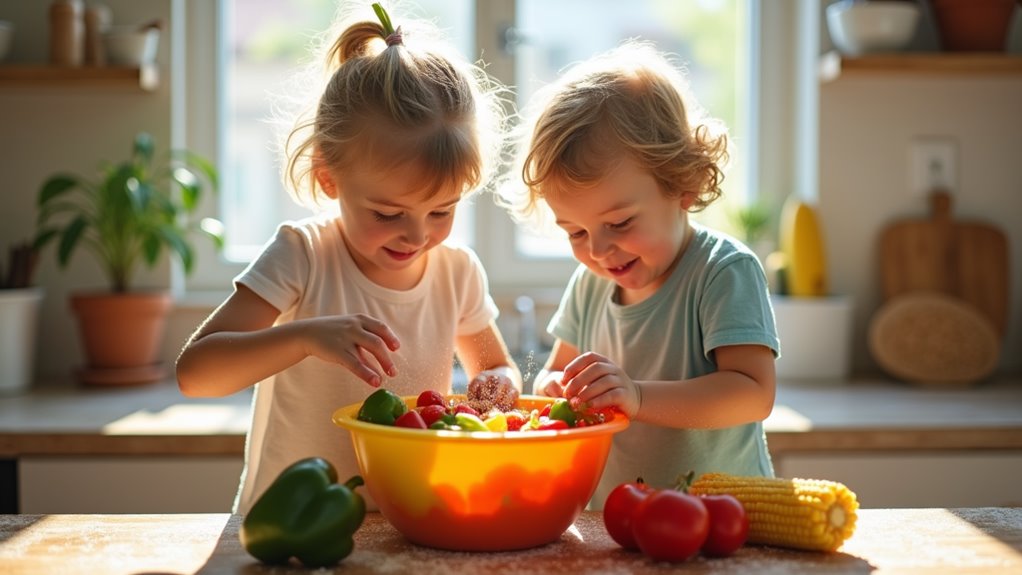Getting your kids involved in meal prep can transform them from picky eaters into excited food lovers! When they help wash veggies or measure ingredients, they're not just cooking; they're learning valuable skills. You can even choose recipes together, making meal planning an adventure! Encourage their creativity by letting them experiment with flavors or decorate their plates. Plus, turning cooking into a fun game helps build positive food associations. As they take pride in their creations, they'll be more willing to try new things. Stick around, and you'll discover even more tips to spark their culinary enthusiasm!
Benefits of Involving Children
Involving children in meal preparation offers numerous benefits that can enhance their culinary skills and foster a love for cooking. When kids help out in the kitchen, they're not just mixing ingredients; they're learning valuable life skills. You'll notice their confidence growing as they chop veggies or stir sauces.
Plus, cooking together can be a great way to bond, turning mealtime into a fun family activity.
Getting your kids involved can also help them develop healthier eating habits. When they see how meals are made and get to choose ingredients, they're more likely to try new foods. "What's this green thing?" becomes a question of curiosity instead of disgust!
And let's not forget about creativity. Cooking gives kids a chance to express themselves. They might come up with a wacky recipe or add too much spice, which can lead to funny moments and delicious surprises.
Age-Appropriate Tasks
As you encourage your kids to join in the kitchen fun, it's important to assign age-appropriate tasks that match their skills and abilities. For younger kids, think about simple jobs like washing fruits and veggies or stirring ingredients in a bowl. They'll feel proud helping out, plus they'll learn about food safety!
As they grow older, you can introduce more challenging tasks. Around age 5 or 6, they might enjoy measuring out ingredients or setting the table. By age 8, they can help with peeling vegetables or even cracking eggs—just keep an eye on those shells!
When they hit the tween years, give them a chance to take charge of a whole recipe. They can chop, mix, or even sauté (with supervision, of course). This not only builds their cooking skills but also boosts their confidence.
Choosing Recipes Together
Choosing recipes together can turn meal preparation into an exciting adventure for you and your kids. It's a great way to bond while teaching them about food. Start by asking your children what they'd like to cook. Let them browse through cookbooks or websites to find recipes that catch their eye. You might be surprised by their choices!
Once you have a few recipes in mind, discuss the ingredients and see what you already have in the pantry. This not only helps with planning but also teaches kids about using what's available.
If a recipe seems too complicated, don't worry! You can simplify it or pick something easier that still excites them.
Make it fun by adding a theme or choosing recipes from different cultures, sparking curiosity about the world. Remember, it's all about enjoying the process together, so don't stress if things don't go perfectly. Cooking can be messy, but that's part of the fun!
After picking your recipes, you'll be ready to tackle the next steps in your cooking adventure. Happy cooking, and watch those picky eaters become more open to trying new foods!
Encouraging Creativity in Cooking
Kids' imaginations can soar when you encourage creativity in cooking. Let them experiment with flavors, colors, and shapes! You might say, "How about we make a rainbow pizza?" This simple idea sparks excitement and opens the door for all sorts of delicious toppings.
Have them pick their favorite veggies and cheeses, turning a regular meal into a colorful masterpiece.
Another fun way to get creative is by letting them invent their own recipes. You could start with a base, like pasta or rice, and ask, "What do you think would taste good with this?" They might surprise you with a mix of ingredients you'd never think to combine!
Don't forget, presentation matters too. Encourage your kids to arrange their dishes in fun shapes or use colorful plates.
You might even host a "food art" night where everyone creates their edible artwork.
Making Meal Prep Fun
Meal prep can often feel like a chore, but with the right approach, it can be a fun and engaging activity for everyone involved. Think of it as a mini-adventure in your kitchen!
First, crank up some music. Who doesn't love dancing while chopping veggies? Let your kids pick a theme for the meal, like "Taco Tuesday" or "Pasta Party." This gets them excited and enthusiastic to help out.
You can turn simple tasks into games. For instance, challenge them to see who can wash the most fruits in a minute. You'll be amazed at how competitive they can get!
Also, don't forget to let them decorate their plates. Use colorful ingredients to make faces or fun shapes. It's like art but edible!
Finally, share stories about the food you're making. Talk about where it comes from or why you love it. This adds a personal touch and makes the process even more special.
Building Positive Food Associations
Creating a joyful atmosphere around food can greatly enhance children's relationship with what they eat. When kids associate cooking and eating with fun, they're more likely to try new foods. You can start by involving them in meal prep, letting them sprinkle herbs or mix ingredients. When they help, they feel proud and excited about what they've created.
Try turning cooking into a game. For instance, you could challenge them to guess the flavors of different spices or create silly names for their dishes. Encourage them to tell stories about the foods they're preparing, connecting it to family traditions or the origins of the ingredients. This helps build positive memories around meals.
You might also consider creating a "food rainbow." Encourage your child to pick colorful fruits and veggies, making a fun competition out of it. The brighter the plate, the better!
Make mealtime a stress-free zone, where everyone shares their favorite parts of the dish. By fostering these joyful experiences, you're helping them develop a positive relationship with food, turning picky eating into curious tasting. Who knows? They might just discover a new favorite!





